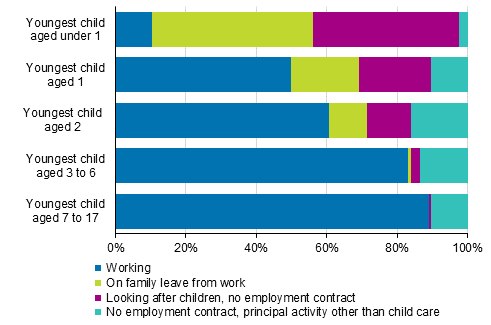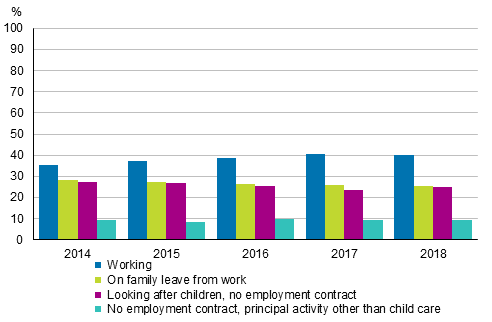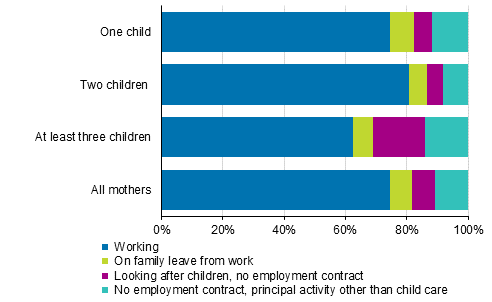4 Working has become more common among mothers
However, the employment rate does not describe how many parents of young children actually work. In the Labour Force Survey employed are those who have worked for at least one hour during the survey week. In addition, employed are also those employees absent from work during the survey week who have a job and who are on maternity or paternity leave or whose absence has lasted under three months. Thus, especially among mothers with children under the age of one, many that are classified as employed are actually on maternity leave. Correspondingly, mothers that are on parental or child care leave from work are usually classified in the inactive population as parental or child care leave are usually taken after the maternity leave, which means the leave is over three months (see Kambur & P�rn�nen, 2017a; Kambur & P�rn�nen, 2017b). This section discusses parents who have been at work during the survey week.
Figures 6 and 7 show mothers who actually go to work as a separate group. It also describes separately the mothers on family leave (maternity, parental or child care leave) from work and those without a valid employment contract who are looking after their children at home. The fourth group consists of those who have said their principal activity is something else than child care. This group includes for example students and unemployed persons.
Very few mothers with children under the age of one were working in 2018, but as many as one-half of mothers with children aged one were working (Figure 6). In families where the youngest child was three to six years of age, a majority of mothers had returned to work. Among all mothers of school-age children 89 per cent were working.
Figure 6. Working and family leaves among mothers aged 20 to 59 by age of their youngest child in 2018, %

Fathers most commonly have family leaves when the family's youngest child is aged under one. At that time, seven per cent of fathers were looking after a child or children either on family leave from work or without an employment relationship.
The level of education affects the mother’s working. Mothers with tertiary level education often have a valid employment contract throughout their family leave and they also return to work faster than other mothers.
In 2018, two-thirds of mothers with tertiary level education whose youngest child was aged between one and two years, had been working during the survey week, while slightly over one-half of mothers with upper secondary level qualifications had been working. Among mothers with tertiary level education, 91 per cent and among those with upper secondary level qualifications, 81 per cent were working when the youngest child was aged between three and six years. On the other hand, among mothers without post-basic level education under one-half were working at this stage.
Figure 7 shows changes having taken place in recent years in work and family leaves among mothers of children aged under three years. Over the last five years the share of working mothers with children under the age of three has increased. In 2018, forty per cent of mothers with children under the age of three were working. The share has increased by five percentage points from 2014. At the same time, the share of mothers on family leave has decreased. In 2018, good one-third of mothers with children aged under three were at home without an employment relationship. This group includes both mothers that primarily care for children at home and those whose main activity is something else than caring for a child, such as studying or unemployment. (Figure 7.)
Figure 7. Working and family leaves of mothers aged 20 to 59 with children aged under three in 2014 to 2018, %

Mothers who have no valid employment relationship and who said their principal activity was child care can be considered stay-at-home mothers. Interpreted like this, five per cent of mothers with one or two children can be classified as stay-at-home mothers. Seventeen per cent of mothers with at least three children were stay-at-home mothers in 2018. Among all families with children, around one-fifth had at least three children. (Figure 8.)
Figure 8. Working and family leaves among mothers aged 20 to 59 by number of children in 2018, %

Source: Labour Force Survey 2018. Statistics Finland
Inquiries: Tarja Nieminen 029 551 3561, Olga Kambur 029 551 3565, tyovoimatutkimus@stat.fi
Director in charge: Jari Tarkoma
Updated 14.11.2019
Official Statistics of Finland (OSF):
Labour force survey [e-publication].
ISSN=1798-7857. Families and work 2018,
4 Working has become more common among mothers
. Helsinki: Statistics Finland [referred: 18.12.2025].
Access method: http://stat.fi/til/tyti/2018/14/tyti_2018_14_2019-11-14_kat_004_en.html

